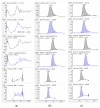Application of HPLC-QQQ-MS/MS and New RP-HPLC-DAD System Utilizing the Chaotropic Effect for Determination of Nicotine and Its Major Metabolites Cotinine, and trans-3'-Hydroxycotinine in Human Plasma Samples
- PMID: 35163947
- PMCID: PMC8839739
- DOI: 10.3390/molecules27030682
Application of HPLC-QQQ-MS/MS and New RP-HPLC-DAD System Utilizing the Chaotropic Effect for Determination of Nicotine and Its Major Metabolites Cotinine, and trans-3'-Hydroxycotinine in Human Plasma Samples
Abstract
The routine techniques currently applied for the determination of nicotine and its major metabolites, cotinine, and trans-3'-hydroxycotinine, in biological fluids, include spectrophotometric, immunoassays, and chromatographic techniques. The aim of this study was to develop, and compare two new chromatographic methods high-performance liquid chromatography coupled to triple quadrupole mass spectrometry (HPLC-QQQ-MS/MS), and RP-HPLC enriched with chaotropic additives, which would allow reliable confirmation of tobacco smoke exposure in toxicological and epidemiological studies. The concentrations of analytes were determined in human plasma as the sample matrix. The methods were compared in terms of the linearity, accuracy, repeatability, detection and quantification limits (LOD and LOQ), and recovery. The obtained validation parameters met the ICH requirements for both proposed procedures. However, the limits of detection (LOD) were much better for HPLC-QQQ-MS/MS (0.07 ng mL-1 for trans-3'-hydroxcotinine; 0.02 ng mL-1 for cotinine; 0.04 ng mL-1 for nicotine) in comparison to the RP-HPLC-DAD enriched with chaotropic additives (1.47 ng mL-1 for trans-3'-hydroxcotinine; 1.59 ng mL-1 for cotinine; 1.50 ng mL-1 for nicotine). The extraction efficiency (%) was concentration-dependent and ranged between 96.66% and 99.39% for RP-HPLC-DAD and 76.8% to 96.4% for HPLC-QQQ-MS/MS. The usefulness of the elaborated analytical methods was checked on the example of the analysis of a blood sample taken from a tobacco smoker. The nicotine, cotinine, and trans-3'-hydroxycotinine contents in the smoker's plasma quantified by the RP-HPLC-DAD method differed from the values measured by the HPLC-QQQ-MS/MS. However, the relative errors of measurements were smaller than 10% (6.80%, 6.72%, 2.04% respectively).
Keywords: HPLC-QQQ-MS/MS chaotropic effect; RP-HPLC-DAD; cotinine; nicotine; trans-3′-hydroxycotinine.
Conflict of interest statement
The authors declare no conflict of interest.
Figures








Similar articles
-
Rapid, sensitive, and reliable quantitation of nicotine and its main metabolites cotinine and trans-3'-hydroxycotinine by LC-MS/MS: Method development and validation for human plasma.J Chromatogr B Analyt Technol Biomed Life Sci. 2021 Aug 1;1179:122736. doi: 10.1016/j.jchromb.2021.122736. Epub 2021 May 5. J Chromatogr B Analyt Technol Biomed Life Sci. 2021. PMID: 34246168
-
Simultaneous and sensitive measurement of nicotine, cotinine, trans-3'-hydroxycotinine and norcotinine in human plasma by liquid chromatography-tandem mass spectrometry.J Chromatogr B Analyt Technol Biomed Life Sci. 2009 Nov 1;877(29):3537-42. doi: 10.1016/j.jchromb.2009.08.033. Epub 2009 Aug 28. J Chromatogr B Analyt Technol Biomed Life Sci. 2009. PMID: 19748838 Free PMC article.
-
Simultaneous serum nicotine, cotinine, and trans-3'-hydroxycotinine quantitation with minimal sample volume for tobacco exposure status of solid organ transplant patients.J Chromatogr B Analyt Technol Biomed Life Sci. 2013 Jun 1;928:139-45. doi: 10.1016/j.jchromb.2013.03.032. Epub 2013 Apr 8. J Chromatogr B Analyt Technol Biomed Life Sci. 2013. PMID: 23632003
-
Review of HPLC-MS methods for the analysis of nicotine and its active metabolite cotinine in various biological matrices.Biomed Chromatogr. 2022 Jun;36(6):e5351. doi: 10.1002/bmc.5351. Epub 2022 Mar 11. Biomed Chromatogr. 2022. PMID: 35106788 Review.
-
The chemical components of electronic cigarette cartridges and refill fluids: review of analytical methods.Nicotine Tob Res. 2015 Mar;17(3):271-9. doi: 10.1093/ntr/ntu197. Epub 2014 Sep 25. Nicotine Tob Res. 2015. PMID: 25257980 Free PMC article. Review.
Cited by
-
Influence of Selective Extraction/Isolation of Heme/Hemoglobin with Hydrophobic Imidazolium Ionic Liquids on the Precision and Accuracy of Cotinine ELISA Test.Int J Mol Sci. 2022 Nov 8;23(22):13692. doi: 10.3390/ijms232213692. Int J Mol Sci. 2022. PMID: 36430168 Free PMC article.
-
Application of Ionic Liquids as Mobile Phase Additives for Simultaneous Analysis of Nicotine and Its Metabolite Cotinine in Human Plasma by HPLC-DAD.Molecules. 2023 Feb 6;28(4):1563. doi: 10.3390/molecules28041563. Molecules. 2023. PMID: 36838551 Free PMC article.
-
Reversed-Phase (RP) and Hydrophilic Interaction (HILIC) Separation Mechanisms for the Assay of Nicotine and E-Cigarette Liquids.Molecules. 2025 Aug 21;30(16):3443. doi: 10.3390/molecules30163443. Molecules. 2025. PMID: 40871595 Free PMC article.
-
Determination of Cotinine, 3'-Hydroxycotinine and Nicotine 1'-Oxide in Urine of Passive and Active Young Smokers by LC-Orbitrap-MS/MS Technique.Molecules. 2024 Aug 1;29(15):3643. doi: 10.3390/molecules29153643. Molecules. 2024. PMID: 39125048 Free PMC article.
References
-
- [(accessed on 31 January 2019)]. Available online: https://www.rch.org.au/clinicalguide/guideline_index/Nicotine_Poisoning/
-
- Rodgman A., Perfetti T.A. The Chemical Components of Tobacco and Tobacco Smoke. 2nd ed. CRC Press, Taylor & Francis Group; Boca Raton, FL, USA: 2013.
-
- Jemal A., Thun M.J., Ries L.A., Howe H.L., Weir H.K., Center M.M., Ward E., Wu X.C., Eheman C., Anderson R., et al. Annual report to the nation on the status of cancer, 1975–2005, featuring trends in lung cancer, tobacco use, and tobacco control. J. Natl. Cancer Inst. 2008;100:1672–1694. doi: 10.1093/jnci/djn389. - DOI - PMC - PubMed
MeSH terms
Substances
LinkOut - more resources
Full Text Sources
Miscellaneous

